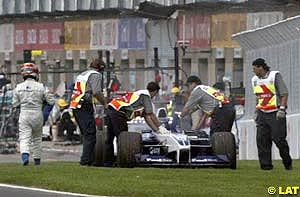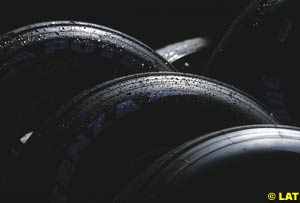
Atlas F1 Columnist
This week's Grapevine brings you |
With the race on to match Ferrari’s performance, all the manufacturers are coming under intense pressure to raise their games, and pull out the stops on their in-season development. The pressure to bring releases forward, and rush through testing programmes, in the quest for speed, is taking a toll.
One of the concepts this engine is built around, is working to the absolutely finest tolerances that BMW believes can last a race distance. Much of the in-season gain in power is based on finding the absolute limit of tolerance by improving the manufacturing processes, and introducing newer, lighter or lower friction components. The work is painstaking, and it is all too common for the computer’s projection of a valid cell to result in what amounts to a small grenade being tested on the dynamometer. These are not the problem units however – poor reliability on track comes from engines which are designed to last 230 miles getting hotter than expected from clutter in the side pods, or a long stop… reducing its range to less than a race distance. Whilst the units are running well, testing all the numerous usage scenarios exhaustively when new components come online is just not a viable option when BMW have performance targets to chase, and Williams need to spend time testing new components and tyres to complete the package. Funny how priorities have changed, now the team is looking at a 75% failure rate.
Renault and Cosworth are also fighting on the limit. The former has a very impressive unit, from a packaging perspective, but getting more power from it is proving difficult. The wide angle V10 is offering some very serious vibrations, particularly near the rev limit. The 840 bhp being generated effectively leaves Renault with a half-second disadvantage to be made up by leveraging the improved packaging options offered by the low engine… a big ask in anyone’s book.
Cosworth, in contrast to Renault, have a powerful engine, though less effective to package. It is believed to be the lightest on the grid, and one of the simplest, but it is a more awkward size and shape than the Renault. Interim improvements seem to be limited to software, updating traction control and fuel consumption, rather than making much impact on power, but the three major upgrades due through the season are supposed to bring fifteen horse-power apiece.
And, of course, there’s Honda. The Japanese manufacturer is frustrated by Toyota’s performance, which is very impressive for a newcomer to the sport. They have been promising regular, significant upgrades through the season, but to date, have only successfully delivered one: the second has been sent back to the shop for more work, as the power curve proved to be a distinct let-down… it was sufficiently jagged that no software solution for a smooth output relative to throttle settings could be derived. Furthermore, whilst top end power was there in abundance, torque at the other end was not as good as that from the first update (delivered for Austria).
When they went to Canada, the Michelin men were looking forward to the fight ahead – after a strategy based coup in Monaco, they were looking forward to a straight, performance based fight. Better still, they had some excellent tyres for the occasion, and were not especially looking for hot weather to make the most of taking the fight to Bridgestone.
Canada was not such a cut and dried case. Williams were always going to be useful there – the circuit suits their package, even without the track temperature rising. The track layout offers relatively easy overtaking opportunities, so qualifying is not as important as race pace. The demands of the long straights combined with riding the curbs at the chicanes offer a pretty decent challenge for the tyre construction, whilst the choice of compound is the usual delicate balance between longevity and outright pace. In the event, the Bridgestone tyres offered pretty similar characteristics, the trade off being around under half a second a lap, in return for an extra seven to ten laps of performance: single stopping on the option tyre was going to be a margin call.
As it turns out, Bridgestone believe that Michelin had the edge in Canada, but this time, the circumstances of the race played the other way to Monaco. Bridgestone’s analysis of both Juan Pablo Montoya and Ralf Schumacher showed that between the poorly timed arrival of the pace car, and the refuelling rig problems, at least one Williams should have been on the podium.
Rerunning the race simulator, programmed with Montoya’s actual racing performance against projected fuel load, showed some interesting results. Had his engine not given up, then he should have caught Schumacher with a lap remaining – which is not to say he would have passed him. Projecting the effect of the safety car staying in, however, showed another result: Montoya ought to have been rejoining from his second stop neck and neck with Barrichello, fighting for second, and about three seconds behind Schumacher in the other Ferrari. To the point, he should have been around half a second a lap quicker than either by the end of the race…
With Ferrari so strong this year, most of the credit for their dominant performances goes to Maranello and Schumacher. Michelin entered the season as underdogs, supplying the rising Williams, and faltering McLaren teams: and they have taken a lions share of the credit for each of these teams’ wins this year.
Bridgestone are gaining some kudos as a technical partner, but they do not believe that the credit they receive is proportional to the impact of their tyres have as part of the package. After Canada, however, Bridgestone are more worried about Michelin’s strengthening performance, rather than raising their profile within the public conception of their role in the Ferrari package.
![]() Manufacturers Push the Boundaries
Manufacturers Push the Boundaries
 BMW have been supplying Williams with some excellent engines this year. The unit is arguably the most powerful on the grid, and even though Ferrari dispute any claim they are down on power, the remainder of the grid believe this is the best engine available. Power peaks at 875bhp, with 19,000 rpm in qualifying trim. In-season development is roughly on schedule, and the target is to end the season with more than 900bhp… However, the unit is starting to look worryingly unreliable: three failures from the last four starts is not a statistic to be proud of.
BMW have been supplying Williams with some excellent engines this year. The unit is arguably the most powerful on the grid, and even though Ferrari dispute any claim they are down on power, the remainder of the grid believe this is the best engine available. Power peaks at 875bhp, with 19,000 rpm in qualifying trim. In-season development is roughly on schedule, and the target is to end the season with more than 900bhp… However, the unit is starting to look worryingly unreliable: three failures from the last four starts is not a statistic to be proud of.
![]() Bridgestone Battle On
Bridgestone Battle On
 Bridgestone still believe their Monaco tyres were basically the right ones to take. Ferrari’s race day performance demonstrated beyond doubt that there was a significant performance advantage over Michelin when the cars ran for anything more than three laps. Had Montoya’s performance not dropped off before his engine gave up, Schumacher should have been right on Coulthard’s tail at the pit stops, offering the obvious passing opportunity. Michelin gambled on being able to defend a strong qualifying performance, and it paid off; but the odds did not actually favour them.
Bridgestone still believe their Monaco tyres were basically the right ones to take. Ferrari’s race day performance demonstrated beyond doubt that there was a significant performance advantage over Michelin when the cars ran for anything more than three laps. Had Montoya’s performance not dropped off before his engine gave up, Schumacher should have been right on Coulthard’s tail at the pit stops, offering the obvious passing opportunity. Michelin gambled on being able to defend a strong qualifying performance, and it paid off; but the odds did not actually favour them.
Please Contact Us for permission to republish this or any other material from Atlas F1.
|
Volume 8, Issue 24
Atlas F1 Exclusive
Exclusive Interview with Frentzen
Ann Bradshaw: View from the Paddock
Canadian GP Review
2002 Canadian GP Review
Canadian GP - Technical Review
Conservative Does It
Stats Center
Qualifying Differentials
SuperStats
Charts Center
Columns
Season Strokes
Elsewhere in Racing
The Grapevine
> Homepage |